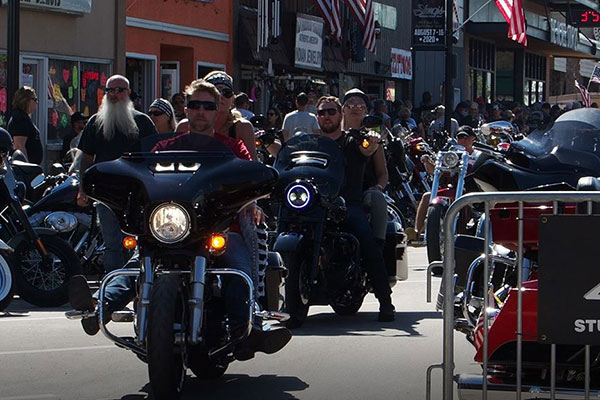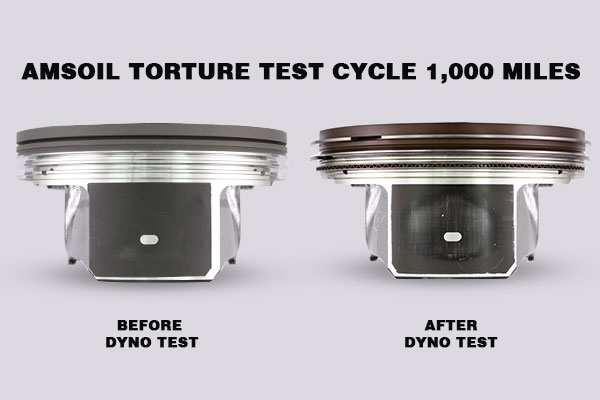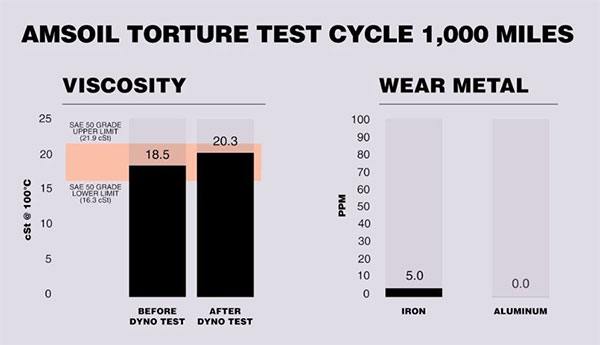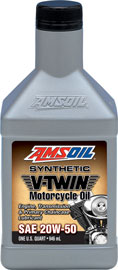See How AMSOIL Performs in the Harley-Davidson® Milwaukee-Eight® Engine
In 2016, Harley introduced its Milwaukee-Eight V-twin engine in part to increase power and reduce engine heat. How does AMSOIL perform in this Harley engine?
We’ll get to that soon, but let’s cover the background story first.
Harley interviewed 1,000 riders in seven cities to find out what they wanted in Harley’s next generation of touring bikes. Two themes emerged: more power and less heat.
Traditional air-cooled V-twin engines, like those used to power most Harleys, can get hot. In fact, some riders have complained about the intense heat radiating from the engine while riding, particularly the rear cylinder, which doesn’t receive as much airflow as the font cylinder.
The engine also suffers from heat
Extreme heat not only challenges rider comfort, it challenges the engine.
If, for example, extreme heat causes the piston to expand beyond acceptable tolerances, it can rub against the cylinder wall and cause scuffing.
Heat also causes some oils to thin and lose viscosity. The oil can become so thin the engine loses oil pressure, causing the oil-pressure gauge to bottom out.
The rider may notice increased valvetrain and gear noise as parts clatter together. Any rider worth his or her salt knows you don’t run an engine with no oil pressure, so he or she shuts it down until the engine cools enough to restore oil pressure.
AMSOIL vs. Harley-Davidson Oil: How We Perform
Air ? liquid
Why do air-cooled V-twins get so hot? And how hot can they get?
It comes down to physics.
Air-cooled engines rely on air flowing over the engine to remove heat. In contrast, liquid-cooled engines, like those found on modern Indian motorcycles, use a coolant/water mixture to absorb engine heat and carry it to a radiator, where it dissipates into the atmosphere.
Air is inherently less efficient removing heat than coolant/water, meaning your average V-twin powering a Harley runs hotter than a liquid-cooled bike.
In fact, our own extreme-heat testing here at AMSOIL revealed the rear-cylinder temperature in a 2012 Harley Street Bob climbed as high as 550ºF (288ºC).
During testing of a 2017 Indian Scout, in contrast, we recorded an average cylinder temperature of 200ºF (93ºC). Granted, the bike didn’t undergo the same test as the Harley, meaning it’s not an apples-to-apples comparison, but it does suggest liquid-cooled bikes run quite a bit cooler than air-cooled bikes.
Riding conditions turn up the heat
Your riding conditions also affect engine heat.
Have you ever gone to Sturgis? Or ridden in a Fourth of July parade or other event at the height of summer?
In Sturgis, riders crawl down Main Street, taking in the sights and sounds. The August sun beats down on the asphalt and radiates onto the bike. Traffic can creep along so slowly that air doesn’t rush over the engine like it does when riding on the highway.
This lack of cooling air moving across the engine can cause heat to climb to dangerous territory.
If it’s bad enough, the electronic temperature controls that safeguard the bike against overheating can trigger, forcing the rider to pull over and stop until the engine cools.
The Harley Milwaukee-Eight runs cooler
I’m no marketing genius, but sitting alongside the road waiting for your bike to cool isn’t good brand strategy. So, the engineers at Harley designed the Milwaukee-Eight engine in part to run cooler.
Right on Harley’s website, the company presents the Milwaukee-Eight as the “…most powerful, coolest-running motor we’ve ever built.”
More power, less heat. Check.
AMSOIL and the Harley Milwaukee-Eight
We bought a 2019 Harley Street Bob with a Milwaukee-Eight 107 engine for extreme-heat testing. We wanted to see how AMSOIL 20W-50 Synthetic V-Twin Motorcycle Oil held up in Harley’s newest engine.
Prior to testing, we instrumented the bike and rode it on the streets to determine the operating conditions that would most severely challenge the bike and the motor oil.
As you might expect, stop-and-go, slow-moving traffic increased heat and presented the most severe conditions, similar to the conditions you see at a bike rally on a hot summer day.
So, our engineers designed a 1,000-mile dyno test meant to replicate the worst-case scenario: slow-moving operation in extreme heat with little-to-no cooling air passing over the engine. 1,000 miles is enough to make 640 trips down Main St. in Sturgis.
How does AMSOIL perform in the Harley Milwaukee-Eight?
The test created conditions that held the oil-sump temperature at a steady 300ºF (149ºC) for 1,000 miles. The rear-cylinder temperature surpassed 420ºF (216ºC). That’s hotter than your bike should ever get.
Heat that extreme chemically breaks down most oils, causing it to lose viscosity and fall out of grade. It can also lead to oxidation, which hastens formation of harmful deposits that can cause the rings to stick, reducing compression and power.
After 1,000 miles of extreme heat, AMSOIL 20W-50 Synthetic V-Twin Motorcycle Oil delivered excellent protection.
Compare a brand-new rear-cylinder piston before the dyno test to one following 1,000 miles. It contains minimal deposits, the rings are free and it’s in great condition.
Chemical analysis following 1,000 miles at 300ºF (149ºC) shows the oil maintained viscosity and virtually prevented wear.
Check out the video to see the full results.
So, does the Milwaukee-Eight run cooler than past Harley V-twin engines?
We’d have to do more testing to definitively say, but all signs point to the affirmative. Notice how the rear-cylinder temperature in our 2012 bike maxed out at 550ºF (288ºC), while the 2019 Harley maxed out just above 420ºF (216ºC). Bear in mind, however, that the two tests aren’t identical, meaning we can’t draw any firm conclusions. But it sure appears that Harley succeeded in reducing heat with its Milwaukee-Eight engine.
That’s thanks to a series of oil-filled cooling lines that circulate around the cylinders and carry heat to an oil cooler.
The oil in your bike should never get this hot. But, if it does, AMSOIL Synthetic V-Twin Motorcycle Oil has you and your Milwaukee-Eight engine covered.







